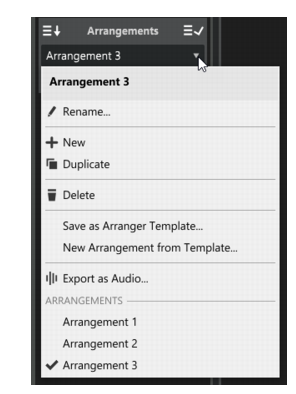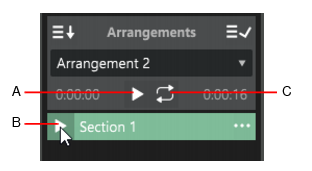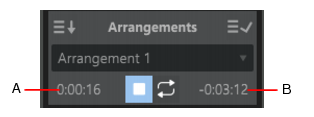To show/hide the Arranger Inspector, do one of the following:

. If one or more sections are selected, only the selected sections will be copied.
or press ALT+SPACEBAR (see To preview an arrangement). The Arrangements list shows the order in which the sections are played back, from top to bottom.
To (destructively) render the current arrangement to the project’s timeline, click the Commit Arrangement to Project button(see To commit an arrangement).
, at which time the Arranger track timeline and the Sections list in the Arranger Inspector inherit the structure of the arrangement.
Figure 125. Arrangements menu.During Arranger preview, the main transport Play buttonshows a small “A” icon to indicate it is playing back an arrangement instead of following the project’s linear timeline, and the active section shows a progress indicator.
Figure 126. Arranger Preview buttons.
renders the arrangement to the project’s timeline and updates track content accordingly.
If you would like to create linked clips when committing an arrangement, hold down the SHIFT key, then click the Commit Arrangement to Project button.
To insert a committed arrangement into the existing project at the Now Time, right-click the Commit Arrangement to Project buttonand select Insert Committed Arrangement.
Figure 127. Arranger Inspector.A. Elapsed time B. Remaining time
Tip - Searching Documentation
Tip: To search for a specific topic, type your search query in the Search Cakewalk.com field at the top right of this page.
When the search results appear, click which product's documentation you would like to search to filter the search results further.
Note - Using Offline Help
Note: If you prefer to always use offline Help, go to Edit > Preferences > File > Advanced in your Cakewalk software and select Always Use Offline Help.
If you are not connected to the internet, your Cakewalk software will default to showing offline help until an internet connection becomes available.










